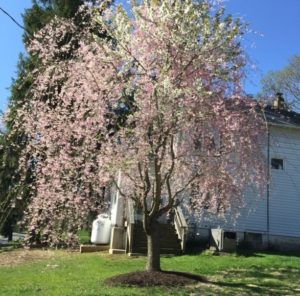Hello fellow readers,
Marcia from Columbia writes, ‘our pink ornamental cherry tree is trans gendering, crossdressing, or something. There are two large boughs with pure white blossoms. What the heck?’ The picture she sent the tree looks like it has a spikey haircut with lots of product.
It turns out weeping cherry trees are often top-grafted trees. The weeping part of the tree, the scion, is grafted onto the rootstock of what the trade calls a standard (a single trunk) to create the umbrella-like shape. In Marcia’s case, the rootstock is likely that of white flowering cherry.
Before pruning a weeping cherry, you must confirm if it’s a natural or a grafted tree by looking for a graft knot on the trunk. Typically it’s just below or about a foot under the crown (the branches).
It sounds like the upright branches on Marcia’s tree are likely from the non-weeping rootstock. Follow the straight branches to where they originate on the trunk and see if they’re below the graft union where the weeping part begins. If so, when the plant is dormant in late fall or early spring, prune the straight branches off at their origin with a clean cut. Messy cuts may inspire more sprouting from the same wound.
Straight branches will never weep on a grafted tree and should be removed to make sure the tree stays weeping. On the other hand, the upward growing branches will eventually arch down on an un-grafted, naturally weeping cherry tree. If you prune them off, the tree will lose its weeping shape.
If all the side shoots on a grafted tree want to grow up rather than weep, it’s better to prune off the whole straight section than to have a tree that can’t make up its mind if it wants to weep or go straight.
By the way, Marcia, only prune weeping branches no more than six inches off the ground. A severe shortening of the weeping branches may weaken the grafted part and encourage the rootstock to dominate. Uh oh! There, there Ed, it’s only a theory. Garden Dilemmas? askmarystone@gmail.com



